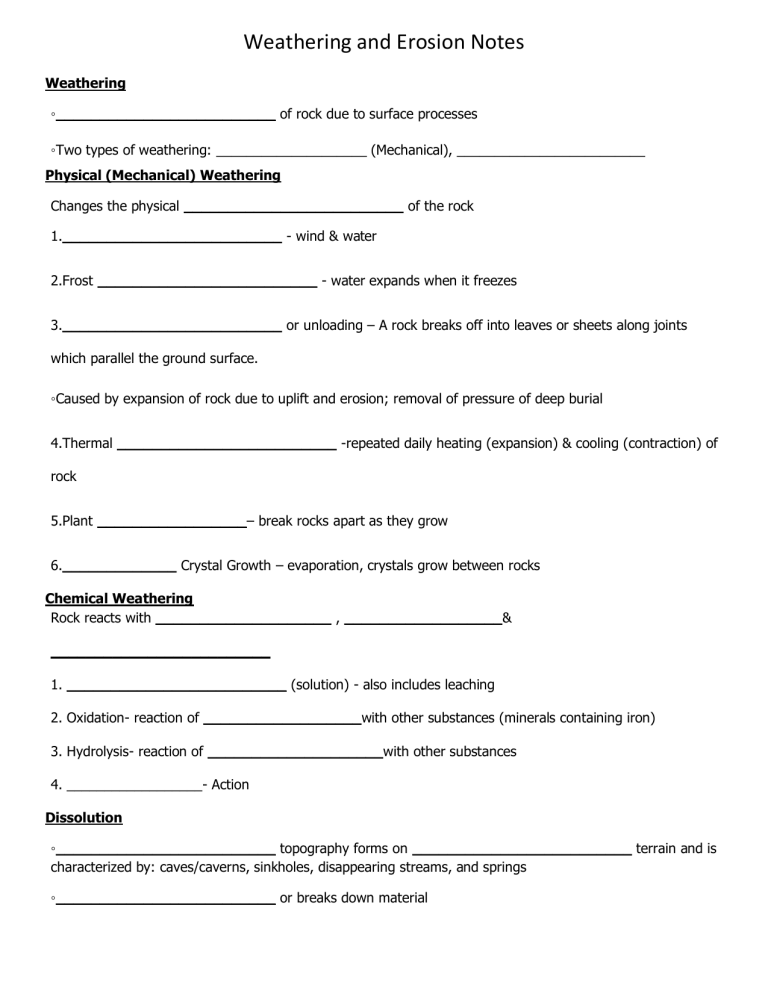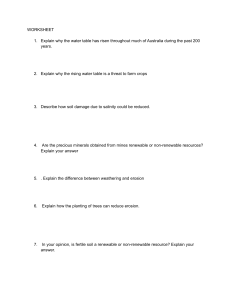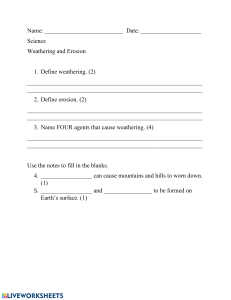
Weathering and Erosion Notes Weathering ◦_________________________ of rock due to surface processes ◦Two types of weathering: ____________________ (Mechanical), _________________________ Physical (Mechanical) Weathering Changes the physical _________________________ of the rock 1._________________________ - wind & water 2.Frost _________________________ - water expands when it freezes 3._________________________ or unloading – A rock breaks off into leaves or sheets along joints which parallel the ground surface. ◦Caused by expansion of rock due to uplift and erosion; removal of pressure of deep burial 4.Thermal _________________________ -repeated daily heating (expansion) & cooling (contraction) of rock 5.Plant _________________– break rocks apart as they grow 6._____________ Crystal Growth – evaporation, crystals grow between rocks Chemical Weathering Rock reacts with ____________________ , __________________& _________________________ 1. _________________________ (solution) - also includes leaching 2. Oxidation- reaction of __________________with other substances (minerals containing iron) 3. Hydrolysis- reaction of ____________________with other substances 4. __________________- Action Dissolution ◦_________________________ topography forms on _________________________ terrain and is characterized by: caves/caverns, sinkholes, disappearing streams, and springs ◦_________________________ or breaks down material Weathering and Erosion Notes ◦Limestone and marble contain calcite and dissolve in limestone. _________________ and _____________________typically form in limestone ◦_____________________ - cave formations; made of calcite ◦Form a rock called _____________________ ◦_________________________ - from _________________________ ◦_________________________ - on _________________________ Sinkholes • A sinkhole is a _________________________ on the Earth’s surface • Can be caused by _________________________ of underlying rock, and overuse of ____________________________ • Test soil composition before building • Treat underground limestone to resist water • Redirect surface water • Mitigation: • Use filters → Pump out water which dissolve underlying rock • Careful inspection of bedrock Oxidation ◦____________________ combines with ________________-bearing silicate minerals causing "_______________________" ◦Iron oxides are _____________, _____________________, or ___________________ in color Hydrolysis-affected by H2O • _________________________ alters to _____________, • _________________ = stable at high temperatures and pressures. • _____________ are stable under conditions at the Earth's surface • ______________________ turns to ____________________ Weathering and Erosion Notes Biological Action ◦____________________, ____________________, and other _________________________________ ◦Chemically and physically change rock Factors Affecting Weathering ◦Mineral ____________________ ◦____________________ ___________________ –____________________particles= ____________________surface area, more available for chemical weathering ◦Type of ____________________ ◦____________________- warm/rainy (____________________) and cold (____________________) Erosion ◦Process that ____________________Earth materials from one place to another ◦________________________: When materials are ____________________in another location Erosion by Running Water ◦Has more ___________________to move large weathered particles, more material, and over a greater ______________________than wind ◦______________Erosion- erosion by running water in _________________channels, on the side of a slope ◦____________________ Erosion- When a channel becomes deep and __________________ (more than 3 meters deep) ◦Rivers entering large bodies of water (lakes, oceans, etc) deposit ____________________amounts of ______________________ ◦These locations are also weathered and eroded constantly by ____________________, ____________________, and ____________________ ◦Islands are also worn down by water Glacial Erosion ◦They ____________________and ____________________out large sections of Earth ◦Because they are so dense, they can carry huge __________ and ____________ over great distances Weathering and Erosion Notes ◦These particles are ____________________when glaciers ____________________proceeding forward or recede backwards Wind Erosion ◦Affect areas most with limited _________________________, high temperatures and little vegetation ◦Wind ____________________- When trees or other vegetation are planted __________________to the direction of the wind to reduce the effects of wind erosion Erosion by Plants, Animals & Humans ◦Earth’s surface materials are constantly relocated as everyday life processes are carried on ◦Examples: Animal’s ___________ into soil; Humans build __________, ____________________ and so on Soil Formation ◦ Caused by ________________ and _______________ ◦ The material that makes up soil is known as its ____________________material. ◦ __________________– dark colored substance in soil from decayed ____________________material ◦ _______________– soil that is made up of equal parts of _______________, _______________, and _________________; best for growing most types of plants ◦ _____________________– measure of how well soil supports plant ____________________ ◦ Soil formation continues over a long period and gradually develops layers called ________________________. Soil Horizons •soil horizon – layer of soil that differs in ________________and ___________________from the layers above or below it •______________________ – the “____” horizon or the top layer is crumbly, dark brown mixture of _________________, ________________and other mineral •_____________________ – the “____” horizon in below topsoil consisting of ________________and other particles washed down from top soil, but __________________humus •“____” horizon – bottom layer containing partly _________________________rock Weathering and Erosion Notes •___________________ – the “__” horizon is _____________________layer of ________________beneath the soil; once exposed bed-rock gradually weathers in smaller particles that are the basic material of soil •Soil is full of living organisms – some are _______________________________that break down the remains of dead organisms and others mix the soil, making space for air and water which help plants thrive. Soil Types •A soil’s _______________________, rate of ________________________and __________________________are determined by its _____________________ •_____________________ Soils-Have good drainage, very _____________________, __________________________often present •________________________________ Soils___________________, _____________________soils, can support diverse environments •_____________________ Soils- Can only support limited vegetation, very ______________ _______horizon, little to no _____________________ matter •_____________________ Soils- Intensely weathered and _____________________soil, can contain high grade iron ore for mining




